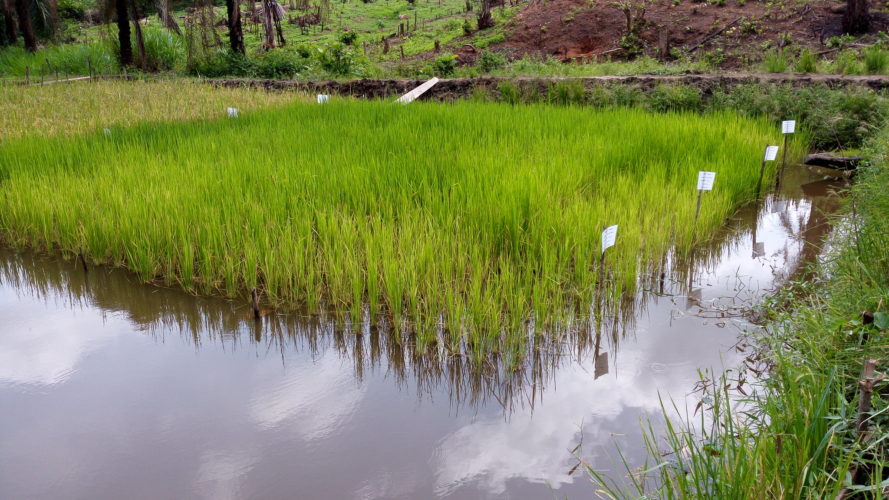Validation and dissemination of integrated fish-rice systems through the Farmer Field Schools (FFS) approach is one of 22 projects the Food and Agriculture Organization of the United Nations (FAO)-Rwanda showcased during the 15th National Agriculture Show (Agrishow). The Agrishow 2022 was organized by the Ministry of Agriculture and Animal Resources (MINAGRI) from 06- 14th July, under the theme “ Building resilience in Agriculture through modern technologies”.
Hundreds of guests who attended the Agrishow could not resist their curiosity, asking about the model experimental plot installed on FAO’s stand. The plot is made of two blocks, the first with rice and fish planted only with animal manure and the second showing feed supplements added. In it, you can see freshly planted rice and small fish swimming in the handmade farm.
“This is really amazing. It is my first time seeing fish integrated into a rice farm. I hope this project will be scaled up around the country. Our country is small and harvesting fish and rice from the same place is very beneficial and good land management,” said Cyprien Sibobugingo, a guest at FAO’s stand at the Agrishow.
“I am going to look for a marshland because I think this is good business. All my farms are on the hillside; otherwise, I would immediately start doing this integrated fish-rice farming,” said Agnes Mukamana, potato farmer.
Meet Joseph Nsekanabo
Joseph Nsekanabo, 54, has been farming rice for more than 36 years. He is one of 264 members of the cooperative of rice farmers in Rwamagana district, Eastern Province, Rwanda. In January 2022, the FAO’s integrated fish-rice project was piloted in Rwanda, and his cooperative was chosen to establish a Farmer Field School (FFS) group to trial this novel approach.
“ I have been farming rice for many years, but this new approach is the most fruitful. We are implementing it on 20 acres, and so far, it is very promising. We have already harvested one ton and 108 kilograms. But before we knew about this innovation, we used to harvest around 800 kilograms in the same area,” he said.
Throughout the Agrishow, Nsekanabo was the first contact for guests who wanted to know more about the integrated fish-rice innovation. Standing before an experimental model plot full of paddy rice and fish fingerlings, he explained the benefits of this approach eloquently.
“ fish eat weeds and pests, promoting weed-control and reducing insect damage. This improves the cultivation of rice while also reducing fish feed requirements and the use of pesticides. It cuts the cost and expenses we incur in rice farming; no chemical fertilizers and pesticides have been used in our plots. I am confident that the spirit of farming as a business will be a reality moving forward. I will be investing a little money and generating more income,” said Nsekanabo while talking to guests at the FAO’s stand.
Integrated rice-fish systems
The integrated rice-fish system is an ancient practice employed by numerous farmers in Asia. China, in particular, has mastered this farming technique where rice and fish grow simultaneously in a symbiotic relationship. Rice-fish co-cultures lessen the environmental impact of agricultural chemicals and help make rice farming more profitable. Ponds have refuge canals. In case of reduced water levels, the fish can seek refuge in the canals. When the water level in the canals is too low for the fish, they will end up in the pond to be harvested. In addition to producing rice and fish for food and nutrition, rice-fish integrated farming practices efficiently use scarce water and land resources; regulate water flows and water quality. Other gains from rice-fish integration include increased income from the production of rice and fish.
“ Integrated fish-rice farming increases fish fertilization rate, improves different species of fingerlings’ survival rates, increases the uptake of fish-farming and improves farmers’ incomes. As Rwanda and the world strive to shift from subsistence to business-oriented farming, this integration is one of the best solutions,” said Mr Orlando Sosa, FAO Agricultural Officer at the Subregional Office for Eastern Africa (SFE).
Rice and fish together in Rwandan paddies
The integrated fish-rice system is a new concept in Rwanda. It is being validated and disseminated by FAO and adapted to local contexts in Ethiopia, Burundi, and Rwanda. Rice is a preferred food for many in Rwanda. To meet the soaring demand for food, there is a need for increased rice and fish production. Farming rice together with fish would be a crucial innovative way of providing sufficient, accessible, and nutritious food.
Article from FAO Rwanda
Photo: Integrated rice fish farming in an inland valley swamp area of Sierra Leone’s Tonkolili district. Credit: Success Kamara.


Comments are closed, but trackbacks and pingbacks are open.